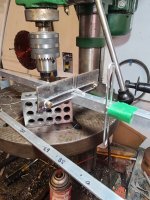Hello from Northwestern Ontario Canada, I am hoping someone here can help me with a Yagi Antenna Array. I have used K7MEM’s calculator for the individual antennas being 23 element @ 1440mhz with an estimated 15.9db gain and 24 degree beam width.
These antennae will be utilized for radio astronomy in a 3 x 3 antenna array pattern omitting the centre antenna only because I can not locate any information on how to phase 9 antennas together with coax. My thoughts are that a square shape pattern would provide a more circular beam and for me more mechanically adaptable vs a rectangular shape. Like wind load leverage.
All I have been able to find is multiples of 2 or 4 for joining antennas together. So at this point I only have information to connect 8 antennas unless someone can help with adding #9 which would be super great because I have material for 9. I do not want to get into expensive off the shelf antenna combiners.
I am also looking for information of beam width and gain for stacking multiple antennas together. There is much information on putting 2 yagi’s together but nothing beyond that unless you have a major in electrical engineering to decipher the formulas. I am just looking for a rule of thumb based on my antenna mentioned above and the number of antenna I want to put into the array.
Information I have found on stacking two yagi antennas together loosely claim 2x db gain (3db) and 1/2 the beam width. But beyond stacking 2 together I have found nothing.
I need the estimated beam width so I can input the data into a radio astronomy program I am running so that it can show a real-time observation (receiving) with the Meridian Drift Scan Table. Once inputted the beam pattern is projected onto the realtime display.
These antenna are of cross polarization design with 2 coax coming from the array to the receiver so left circular, right circular, horizontal or vertical polarization can be achieved.
Thank you,
Bob
These antennae will be utilized for radio astronomy in a 3 x 3 antenna array pattern omitting the centre antenna only because I can not locate any information on how to phase 9 antennas together with coax. My thoughts are that a square shape pattern would provide a more circular beam and for me more mechanically adaptable vs a rectangular shape. Like wind load leverage.
All I have been able to find is multiples of 2 or 4 for joining antennas together. So at this point I only have information to connect 8 antennas unless someone can help with adding #9 which would be super great because I have material for 9. I do not want to get into expensive off the shelf antenna combiners.
I am also looking for information of beam width and gain for stacking multiple antennas together. There is much information on putting 2 yagi’s together but nothing beyond that unless you have a major in electrical engineering to decipher the formulas. I am just looking for a rule of thumb based on my antenna mentioned above and the number of antenna I want to put into the array.
Information I have found on stacking two yagi antennas together loosely claim 2x db gain (3db) and 1/2 the beam width. But beyond stacking 2 together I have found nothing.
I need the estimated beam width so I can input the data into a radio astronomy program I am running so that it can show a real-time observation (receiving) with the Meridian Drift Scan Table. Once inputted the beam pattern is projected onto the realtime display.
These antenna are of cross polarization design with 2 coax coming from the array to the receiver so left circular, right circular, horizontal or vertical polarization can be achieved.
Thank you,
Bob





